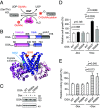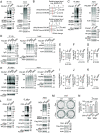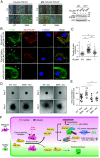OGA mutant aberrantly hydrolyzes O-GlcNAc modification from PDLIM7 to modulate p53 and cytoskeleton in promoting cancer cell malignancy
- PMID: 38838015
- PMCID: PMC11181094
- DOI: 10.1073/pnas.2320867121
OGA mutant aberrantly hydrolyzes O-GlcNAc modification from PDLIM7 to modulate p53 and cytoskeleton in promoting cancer cell malignancy
Abstract
O-GlcNAcase (OGA) is the only human enzyme that catalyzes the hydrolysis (deglycosylation) of O-linked beta-N-acetylglucosaminylation (O-GlcNAcylation) from numerous protein substrates. OGA has broad implications in many challenging diseases including cancer. However, its role in cell malignancy remains mostly unclear. Here, we report that a cancer-derived point mutation on the OGA's noncatalytic stalk domain aberrantly modulates OGA interactome and substrate deglycosylation toward a specific set of proteins. Interestingly, our quantitative proteomic studies uncovered that the OGA stalk domain mutant preferentially deglycosylated protein substrates with +2 proline in the sequence relative to the O-GlcNAcylation site. One of the most dysregulated substrates is PDZ and LIM domain protein 7 (PDLIM7), which is associated with the tumor suppressor p53. We found that the aberrantly deglycosylated PDLIM7 suppressed p53 gene expression and accelerated p53 protein degradation by promoting the complex formation with E3 ubiquitin ligase MDM2. Moreover, deglycosylated PDLIM7 significantly up-regulated the actin-rich membrane protrusions on the cell surface, augmenting the cancer cell motility and aggressiveness. These findings revealed an important but previously unappreciated role of OGA's stalk domain in protein substrate recognition and functional modulation during malignant cell progression.
Keywords: O-GlcNAcase; O-GlcNAcylation; PDLIM7; cancer; deglycosylation.
Conflict of interest statement
Competing interests statement:The authors declare no competing interest.
Figures






References
-
- Zachara N. E., Akimoto Y., Boyce M., Hart G. W., “The O-GlcNAc modification” in Essentials of Glycobiology [Internet], Varki A., et al., Eds. (Cold Spring Harbor Laboratory Press, ed. 4, 2022), chap. 19 (22 February 2023).
MeSH terms
Substances
Grants and funding
LinkOut - more resources
Full Text Sources
Molecular Biology Databases
Research Materials
Miscellaneous

